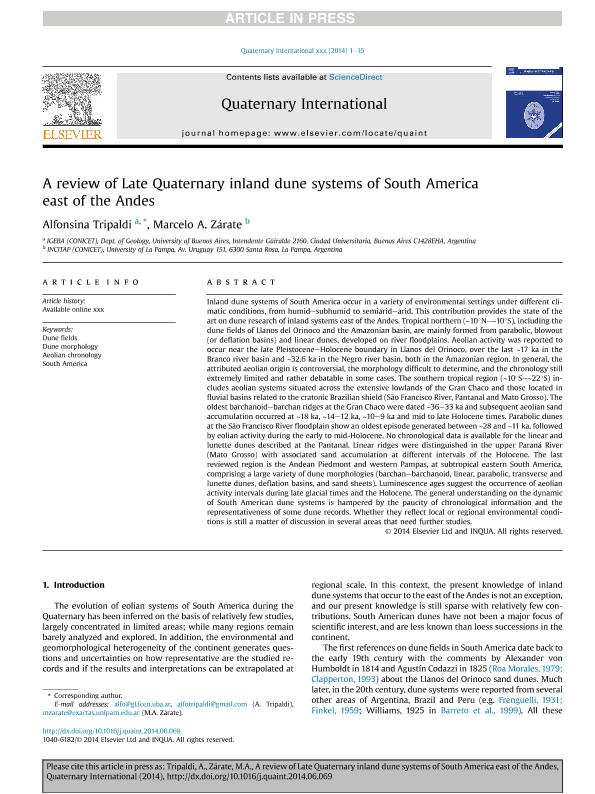Mostrar el registro sencillo del ítem
dc.contributor.author
Tripaldi, Alfonsina

dc.contributor.author
Zárate, Marcelo Arístides

dc.date.available
2017-06-21T15:55:18Z
dc.date.issued
2014-07
dc.identifier.citation
Tripaldi, Alfonsina; Zárate, Marcelo Arístides; A review of Late Quaternary inland dune systems of South America east of the Andes; Elsevier; Quaternary International; 410; Part B; 7-2014; 96-110
dc.identifier.issn
1040-6182
dc.identifier.uri
http://hdl.handle.net/11336/18533
dc.description.abstract
Inland dune systems of South America occur in a variety of environmental settings under different climatic conditions, from humid–subhumid to semiarid–arid. This contribution provides the state of the art on dune research of inland systems east of the Andes. Tropical northern (∼10°N–∼10°S), including the dune fields of Llanos del Orinoco and the Amazonian basin, are mainly formed from parabolic, blowout (or deflation basins) and linear dunes, developed on river floodplains. Aeolian activity was reported to occur near the late Pleistocene–Holocene boundary in Llanos del Orinoco, over the last ∼17 ka in the Branco river basin and ∼32.6 ka in the Negro river basin, both in the Amazonian region. In general, the attributed aeolian origin is controversial, the morphology difficult to determine, and the chronology still extremely limited and rather debatable in some cases. The southern tropical region (∼10°S–∼22°S) includes aeolian systems situated across the extensive lowlands of the Gran Chaco and those located in fluvial basins related to the cratonic Brazilian shield (São Francisco River, Pantanal and Mato Grosso). The oldest barchanoid–barchan ridges at the Gran Chaco were dated ∼36–33 ka and subsequent aeolian sand accumulation occurred at ∼18 ka, ∼14–12 ka, ∼10–9 ka and mid to late Holocene times. Parabolic dunes at the São Francisco River floodplain show an oldest episode generated between ∼28 and ∼11 ka, followed by eolian activity during the early to mid-Holocene. No chronological data is available for the linear and lunette dunes described at the Pantanal. Linear ridges were distinguished in the upper Paraná River (Mato Grosso) with associated sand accumulation at different intervals of the Holocene. The last reviewed region is the Andean Piedmont and western Pampas, at subtropical eastern South America, comprising a large variety of dune morphologies (barchan–barchanoid, linear, parabolic, transverse and lunette dunes, deflation basins, and sand sheets). Luminescence ages suggest the occurrence of aeolian activity intervals during late glacial times and the Holocene. The general understanding on the dynamic of South American dune systems is hampered by the paucity of chronological information and the representativeness of some dune records. Whether they reflect local or regional environmental conditions is still a matter of discussion in several areas that need further studies.
dc.format
application/pdf
dc.language.iso
eng
dc.publisher
Elsevier

dc.rights
info:eu-repo/semantics/openAccess
dc.rights.uri
https://creativecommons.org/licenses/by-nc-nd/2.5/ar/
dc.subject
Dune Fields
dc.subject
Dune Morphology
dc.subject
Aeolian Chronology
dc.subject
South America
dc.subject.classification
Geología

dc.subject.classification
Ciencias de la Tierra y relacionadas con el Medio Ambiente

dc.subject.classification
CIENCIAS NATURALES Y EXACTAS

dc.title
A review of Late Quaternary inland dune systems of South America east of the Andes
dc.type
info:eu-repo/semantics/article
dc.type
info:ar-repo/semantics/artículo
dc.type
info:eu-repo/semantics/publishedVersion
dc.date.updated
2017-06-21T15:33:47Z
dc.journal.volume
410
dc.journal.number
Part B
dc.journal.pagination
96-110
dc.journal.pais
Países Bajos

dc.journal.ciudad
Amsterdam
dc.description.fil
Fil: Tripaldi, Alfonsina. Consejo Nacional de Investigaciones Científicas y Técnicas. Oficina de Coordinación Administrativa Ciudad Universitaria. Instituto de Geociencias Basicas, Aplicadas y Ambientales de Buenos Aires. Universidad de Buenos Aires. Facultad de Ciencias Exactas y Naturales. Instituto de Geociencias Basicas, Aplicadas y Ambientales de Buenos Aires; Argentina
dc.description.fil
Fil: Zárate, Marcelo Arístides. Consejo Nacional de Investigaciones Científicas y Técnicas. Instituto de Ciencias de la Tierra y Ambientales de la Pampa. Universidad Nacional de la Pampa. Facultad de Cs.exactas y Naturales. Instituto de Ciencias de la Tierra y Ambientales de la Pampa; Argentina
dc.journal.title
Quaternary International

dc.relation.alternativeid
info:eu-repo/semantics/altIdentifier/doi/https://doi.org/10.1016/j.quaint.2014.06.069
dc.relation.alternativeid
info:eu-repo/semantics/altIdentifier/url/http://www.sciencedirect.com/science/article/pii/S1040618214004522
Archivos asociados
